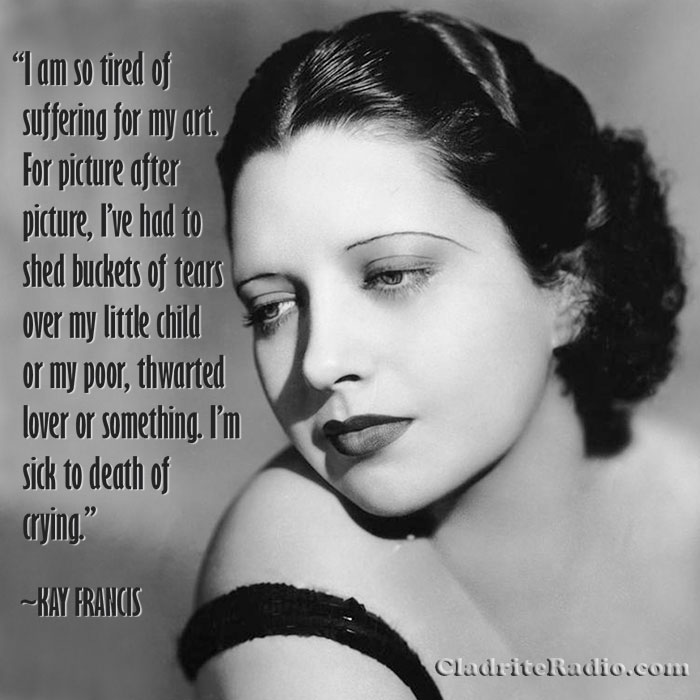Here are 10 things you should know about Ann Savage, born 99 years ago today. Few Hollywood actors have been as closely associated with a single role as Savage is with her portrayal of Vera in DETOUR (1945).
Tag: Poverty Row
Happy 112th Birthday, Kay Francis!
Fashion plate and Queen of the Women’s Pictures Kay Francis was born Katherine Edwina Gibbs 112 years ago today in Oklahoma City, Oklahoma. Here are 10 KF Did-You-Knows:
- Though Francis was born in Oklahoma City, she didn’t live there long. Much of her childhood was spent on the road with her mother, Katherine Clinton, who was an actress. At age 17, Francis, who was then attending Katherine Gibbs Secretarial School in New York City, married the first of her five husbands—one James Dwight Francis, member of a prominent (and well-to-do) Pittsfield, Massachusetts, family. That marriage, like the four other matrimonial knots Francis would eventually tie, unraveled in relatively short order.
- Shortly after her 1925 divorce, Francis decided to follow her mother’s example and pursue a life on the stage. In November of that year, she made her Broadway debut as the Player Queen in a modern-dress version of Shakespeare’s Hamlet.
- After a handful more Broadway roles, Walter Huston, her costar in the 1928 production of Elmer the Great, encouraged her to take a screen test for Paramount Pictures. She did, and was given roles in Gentlemen of the Press (1929) and the Marx Brothers‘ first picture, The Cocoanuts (1929), both of which were filmed at Paramount’s Astoria Studios in Queens, NY.
- Soon thereafter, Francis moved to Hollywood where her striking looks and model’s figure (she stood 5’9″, very tall for an actress at the time) helped her career to ascend. From 1929 to 1931, she appeared in more than twenty films.
- Warner Brothers wooed Francis away from Paramount in 1932, and it was there that she experienced her greatest success. By the mid-’30s, Francis was the queen of the Warner Brothers lot and one of the highest-paid people in the United States. From 1930-37, Francis appeared on the cover of more than 38 movie magazines, second only to Shirley Temple (who racked an astonishing 138 covers over that span).
- At Warner Brothers, Kay became known as a clotheshorse. Her ability to wear stylish clothes well was highly valued by the studio and admired by fans; in fact, she eventually came to feel that Warner Brothers put more more of a focus on her on-screen wardrobe than her film’s scripts, as she came to be unalterably associated with the sort of weepy melodramas that were then known as “women’s pictures.” We fully understand the frustration she felt at the time, but we’ll admit that we love those pictures and adore Francis’ performances in them.
- Francis’ great success came in spite of a noticable speech impediment: She pronounced R’s as W’s (ala Elmer Fudd). As such, our favorite line of Kay Francis dialogue appears in Mandalay (1934), which was directed by Michael Curtiz and in which Kay starred with Ricardo Cortez, Lyle Talbot, and Warner Oland. It’s great fun to hear her intone, “Gwegowy, we awwive at Mandalay tomowwow.”
- Francis’ personal life was something of a mess. An exceedingly liberated person, sexually, she slept with both men and with women—and plenty of them, and none of her five marriages lasted very long.
- Francis’s career fell as quickly as it had risen. She was through with the movies (or perhaps vice versa) by 1946, when she appeared in her final picture, Wife Wanted, a budget quickie made for the infamous Poverty Row studio Monogram Pictures. Aside from some stage work in the late ’40s and a couple of TV appearences in the early ’50s, she avoided the spotlight thereafter and was largely forgotten by the public (until Turner Classic Movies began to feature her pictures prominently in its programming and her star again rose among old-movie buffs).
- When she died in 1968 of breast cancer, Kay Francis left more than one million dollars to The Seeing Eye, Inc., an organization that trains guide dogs for the blind.
Happy birthday, Kay Francis, wherever you may be!

Happy 99th Birthday, Marsha Hunt!
The lovely Marsha Hunt, born Marcia Virginia Hunt in Chicago, Illinois, is celebrating her 99th birthday today! Here are some MA Did-You-Knows:
- The daughter of an attorney and voice teacher, Hunt and her family moved to New York City when she was three years old. She took an interest in performing at an early age, appearing in school plays and performing at church functions.
- After graduating from NYC’s Horace Mann High School (at age 16!), she worked as a model and as a singer on the radio while studying drama at the Theodora Irvine’s Studio of the Theatre (where Cornel Wilde was one of her classmates)
- At 17 (and accompanied by her older sister), Hunt moved to Hollywood to pursue a career in motion pictures. She was quickly signed by Paramount Pictures and in 1935 made her debut in The Virginia Judge. She was relegated to mostly B pictures at Paramount and when her career failed to take off, she began to freelance at various studios, including many of the Poverty Row outfits.
- In 1939, Hunt signed with MGM, where she was given solid parts but rarely lead roles. Her association with MGM came to an end in 1945 and she began freelance again (it was during this period that she appeared as the “good girl” counterpart to Claire Trevor‘s “bad girl” in Anthony Mann‘s classic film noir Raw Deal (1948).
- In 1948, Hunt decided to give Broadway a try, debuting in Joy to the World. She appeared in a number of other shows as well, including a turn as Anna in a production of The King and I. She also appeared on Broadway with Johnny Carson, in a production called Tunnel of Love.
- Hunt was a lifelong liberal and in the early 1950s, some of her past political activities unfairly came back to haunt her. Although she was never called to testify before the House Un-American Activities Committee, her name appeared in the infamous Red Channels pamphlet that purported to expose Communists and other subversives in the radio and television industries. She made just three films in the next eight years.
- Semi-retired thereafter, Marcia has devoted herself to humanitarian causes and organizations, among them UNICEF, The March of Dimes and The Red Cross.
- Hunt was named the honorary mayor of Sherman Oaks, California, in 1983 and still holds that “post” today.
- In 1993, Hunt published a book on fashion entitled The Way We Wore.
- In 1998, Hunt received the Eleanor Roosevelt Humanitarian Award for her charitable and humanitarian activities.
Happy birthday, Marsha Hunt, and many happy returns of the day!

Happy 133rd Birthday, Bela Lugosi!
It’s interesting to consider how sad a figure Bela Lugosi—born Béla Ferenc Dezsõ Blaskó 133 years ago to day in Lugos, Kingdom of Hungary (now Lugoj, Romania)—remains in the minds of so many today. After all, he enjoyed a long and largely successful acting career, enjoying stage success first in his native land and later in the United States.
He appeared in his first film in Hungary in 1917, but soon thereafter emigrated to Germany (where he made a few more films) before finally arriving in the U.S.
His acting career began just after the turn of the 20th century in provincial theatres before he moved to Budapest in 1911. There, he worked with the National Theatre of Hungary from 1913-1919 (with some time off to serve as an infantryman in the Austro-Hungarian Army in the First World War).
A union activist, he felt at risk in Hungary during the Hungarian Revolution of 1919, so he left first for Vienna before settling in Berlin, where he continued to act. Eventually, he took an assignment as a merchant marine and made his way first to New Orleans and then to New York, where he underwent legal immigration inspection at Ellis Island in 1921.
In New York, Lugosi formed a stock company with a group of fellow Hungarians that toured the East Coast. He made his Broadway debut in 1922 and continued to work on the Great White Way for several years.
Lugosi first did film work in Hungary, and continued to appear in films in Berlin. His first American film work (he had previously appeared in movies in both Hungary and Germany) was in a 1923 melodrama called The Silent Command (and if you can believe it, he appeared in 48 pictures, all totaled, before Dracula).
In 1927, Lugosi was cast in the role that would prove a blessing and a curse for the rest of his life in a Broadway production of Dracula, based on the Bram Stoker novel. The production ran for 261 performances before touring the country, and the acclaim Lugosi received in the role of the bloodthirsty count led to him being offered the same role in the Tod Browning picture (though it’s said in some circles that he wasn’t the first choice for the role; rumors have long had it that Lon Chaney was originally slated for the role before his premature death in 1930).
Dracula rocketed Lugosi to stardom, but thereafter he found it difficult to get any roles outside the horror genre. Not that he didn’t pursue non-horror roles—he did, in earnest—but they were not forthcoming, and by the mid-1930s, when horror films became less of a focus at Universal Studios, Lugosi found himself assigned to the studio’s non-horror B unit, which led to small roles in lesser pictures. As a result, he frequently accepted leading roles in low-budget thrillers produced by Poverty Row companies, roles that helped pay the bills but did little to broaden the range of roles to which he was suited in the eyes of producers and the moviegoing public.
To make it worse, Lugosi suffered badly with sciatica, which doctors treated with morphine and, later, methadone. So he endured a lengthy battle with addiction to those medications, and when news spread of his reliance on painkillers, his career suffered even more.
By the 1950s, Lugosi was reduced to playing the villain in very low-budget comedies (Bela Lugosi Meets a Brooklyn Gorilla) and the even lower-budget unintentional comedies churned out by legendary (if inept) auteur Edward D. Wood, Jr. Finally, on August 16, 1956, Lugosi’s heart gave out.
Lugosi seemed a goodhearted sort, and one certainly wishes his career (and personal life—he was married five times) had worked out more to his favor, but his pictures continue to bring joy (and chills) to movie lovers today (TCM is teaming with Fathom Events to screen Dracula, in a double bill with Universal’s Spanish language version of that film, starring Carlos Villarías, in theatres around the country on October 25th and 28th). That’s a legacy that anyone might envy.

